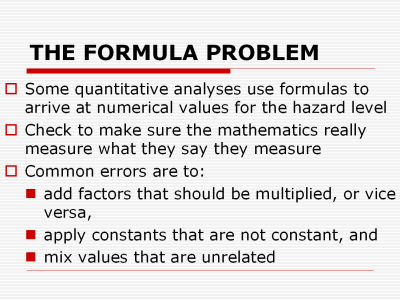The quantitative approach may use a formula to develop
numerical values for a hazard.
Examine the actual formula
to make certain that the mathematics actually measure what
the users say the formula measures.
In some cases, even in work done by recognized scientific
specialists, there are obvious errors in how the mathematical
relationships have been described.
Factors that add to each other should be added, not
multiplied. Factors that
multiply the effect of other factors should be multiplied, not
added. In some cases
constants are used that are not actually constant through the range
of the event or throughout all of the events to which the formula is
applied. In some cases values
are mixed together which are not related to each other.
And different impacts may be measured in different ways, or
different formulas may be used to generate data that seems to be the
same to compare different events.
The following slide provides an example of how some of these
factors can be misapplied in an analysis.
